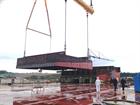Carrier update November
Queen Elizabeth
The final piece of the gigantic jigsaw that is the Royal Navy’s future carrier HMS Queen Elizabeth is in place with her ski ramp completed. Only the aircraft lifts need to be added to complete outward construction of the 65,000-tonne leviathan in Rosyth.
The hull of the carrier is now complete after the last section of her ‘ski ramp’, which will help F35 Lightning IIs get airborne off the expansive flight deck, was fitted at Rosyth dockyard 10 November.
The Long range radar was fitted to the forward island 22 November.
As well as 10,000 people across the country involved in the construction of the two carriers, Queen Elizabeth has a 50-strong ship’s company who are helping her introduction into service, writing her ‘instruction manual’.
Completed compartments are continually being signed off and handed over. The pictured galley being the final compartment in LB03 to be handed over for inspection.
Prince of Wales
All four propulsion motors have been delivered to the block build sites. Just as with Queen Elizabeth, building of the various blocks continues in Portsmouth, Govan, Merseyside and Tyne. Detailed technical summaries can be read in the weekly newsletters for November, below.
You tube video of diesel generator being fitted at Govan, 10/11 November.
From Ian Booth Programme Director for Aircraft Carrier Alliance
Recently the Secretary of State for Defence made an important announcement regarding the future of the QEC programme. I would like to draw your attention to his words. He said:
“Following 18 months of complex negotiations with industry, I am pleased to inform the House that we have now reached heads of terms with the alliance that will address directly the concerns articulated by the PAC and others. Under the revised agreement, the total capital cost to Defence of procuring the carriers will be £6.2 billion, a figure arrived at after detailed analysis of costs already incurred and future costs and risks over the remaining seven years to the end of the project. Crucially, under the new agreement, any variation above or below that price will be shared on a 50:50 basis between Government and industry, until all the contractor’s profit is lost, meaning that interests are now properly aligned, driving the behaviour change needed to see this contract effectively delivered”
This is a very significant step for the programme. Once implemented it will put us on a sound footing for delivery against stretching but achievable schedule and cost targets, while providing a strong commercial incentive to deliver.
This will call for us to examine everything we do and to look for ways to do things faster and better, reducing waste, inefficiency and rework so that we deliver the two aircraft carriers cost effectively and on time.
I look forward to the news headlines we will create over the next few years. By the end of this year HMS Queen Elizabeth will be structurally complete and she will be afloat next summer. Handover in 2017 will see her well on track to meet the target of flying jets from her in 2018. HMS Prince of Wales will follow closely behind with both ships in the hands of the Royal Navy by the end of 2019.
There is much work to do as we continue to proudly deliver the nation’s flagships.





